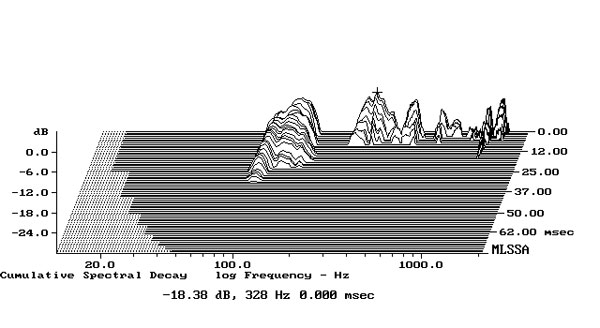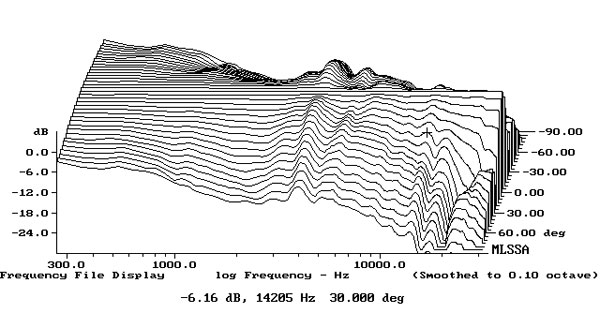| Columns Retired Columns & Blogs |
As a less expensive alternative to Parasound JC1+, one of the good choices would be the Mark Levinson 5805 integrated amp ...... Stereophile measurements show ML 5805 can handle 2 Ohm loads :-) ........
I used DRA Labs' MLSSA system and a calibrated DPA 4006 microphone to measure the GoldenEar BRX's frequency response in the farfield, and an Earthworks QTC-40 mike for the nearfield and in-room responses.
GoldenEar specifies the BRX's sensitivity as 90dB/W/m; my estimate was somewhat lower, at 87.5dB(B)/2.83V/m. The BRX's impedance is specified as "compatible with 8 ohms." However, the impedance magnitude (fig.1, solid trace) drops well below 8 ohms in the midrange and mid-treble region, with a minimum value of 3.24 ohms at 194Hz. There is also a combination of 5 ohms impedance magnitude with an electrical phase angle of –45° (dashed trace) at 120Hz. As the phase angle is relatively high in several regions, I used a result from a 1994 AES paper by Eric Benjamin to calculate what UK writer Keith Howard has called the "equivalent peak dissipation resistance" (EPDR, footnote 1). The BRX has minimum EPDRs of 2.15 ohms at 59Hz and 1.53 ohms at 135Hz, and the EPDR remains below 4 ohms in the midrange. This loudspeaker will work best with amplifiers that are comfortable driving loads below 4 ohms, which I suspect is why it proved a better match with the Parasound monoblocks than with the NAD integrated.
The traces in fig.1 are free from the small discontinuities that would imply the presence of resonances. When I investigated the enclosure's vibrational behavior with a plastic-tape accelerometer, I found resonant modes at 328Hz on the top panel (fig.2) and 527Hz on the sidewalls. These modes were very low in level, however.


The saddle centered at 51Hz in the impedance magnitude trace suggests that this is the tuning frequency of the twin passive radiators. The minimum-motion notch in the woofer's output (fig.3, blue trace) lies close to that frequency, at 49Hz. Measuring the nearfield output of the passive radiators was problematic: Wherever I placed the microphone, the measurement was contaminated at the high end of the radiators' range by the woofer's output. (The radiators' relatively large radiating area means that the intensity of their sound is low at any specific microphone position.) I therefore removed one of the flush side-mounted grilles—with difficulty, as they are held in place with nonhardening adhesive putty—and attached a plastic-tape accelerometer to one of the radiators with blue tape. This eliminated higher-frequency crosstalk from the woofer but resulted in a slightly lower tuning frequency because of the additional mass.

The red trace in fig.3 is therefore a composite, derived from the accelerometer output above 50Hz and the microphone output below that frequency. It peaks between 40Hz and 70Hz, with a relatively clean upper-frequency rolloff. There is the usual bump in the upper bass in both the woofer and radiator outputs due to the nearfield measurement technique.
The GoldenEar's farfield response, taken without the rather bulky grille and averaged across a 30° horizontal window centered on the tweeter axis, is shown as the black trace above 300Hz in fig.3. The balance above the slightly suppressed midrange is superbly flat and even up to the top of the audioband. Repeating the measurement with the grille in place (green trace) gives a little less low-treble energy and introduces some small peaks and dips in the high treble.
Fig.4 shows the GoldenEar's horizontal dispersion, normalized to the response without the grille on the tweeter axis, which thus appears as a straight line. The apparent peak at 3.5kHz to the speaker's sides is likely due to the small peak between 3kHz and 4kHz increasing in amplitude off-axis. The BRX's radiation pattern narrows a little at the top of the woofer's passband. Similarly, the tweeter becomes more directional above the cursor position in this graph of 14kHz. Other than those issues, the contour lines in this graph are relatively evenly spaced, this correlating with the stable stereo imaging I noted in my auditioning. In the vertical plane (fig.5), again with the off-axis response normalized to the tweeter-axis response, the small peak in the presence region flattens out 5–10° below the tweeter axis, which presumably is why GoldenEar recommends using a stand with the BRX that is sufficiently high to place the listener's ear just below the tweeter axis.


The red trace in fig.6 shows the BRXes' spatially averaged response in my room, generated by averaging 20 1/6-octave–smoothed spectra, taken for the left and right speakers individually using a 96kHz sample rate, in a vertical rectangular grid 36" wide by 18" high and centered on the positions of my ears. This tends to average out the peaks and dips below 400Hz that are due to the room's resonant modes. For reference, the blue trace shows the spatially averaged response of the KEF LS50 that I reviewed in November 2012. Both pairs of speakers were placed in identical positions on 24" stands for the in-room measurements.

The in-room responses of the LS50 and BRX are superficially similar. However, the GoldenEar's balance is smoother in the low treble and adds a little more energy in the top two octaves. The GoldenEars have more output in the upper bass, though they don't excite the lowest frequency mode in my room to as large an extent as the KEFs. While performing these measurements, I noticed that the responses at the listening position of the two BRXes were closely matched in the midrange and treble.
In the time domain, the BRX's step response on the tweeter axis (fig.7) indicates that the tweeter is connected in inverted acoustic polarity, the woofer in positive polarity. The decay of the tweeter's step smoothly blends with the positive-going start of the woofer's step, which implies optimal crossover implementation. Other than a very small amount of delayed energy at the frequency of the on-axis peak in the presence region, the GoldenEar BRX's cumulative spectral-decay plot (fig.8) is superbly clean overall.


The GoldenEar BRX offers excellent measured performance, but it is a somewhat demanding load for the partnering amplifier.—John Atkinson

As a less expensive alternative to Parasound JC1+, one of the good choices would be the Mark Levinson 5805 integrated amp ...... Stereophile measurements show ML 5805 can handle 2 Ohm loads :-) ........

Thank you JA2 for reviewing the ML 5805 and doing the 'heavy lifting' :-) .......

JA1 should include the ML 5805 as one of his reference (integrated) amplifiers as a part of his reference amplifier arsenal :-) .........

Is it possible for JA1 to do the EPDR measurements in retrospect, for at least some of the class-A speakers? ...... The impedance and phase measurements are already available for those speakers :-) ......

JA1 says, "I don't have time for that EPDR measurements ..... Go buy the Parasound JC1+ amps" ....... Just kidding .... Just kidding :-) .......

Is it possible for JA1 to do the EPDR measurements in retrospect, for at least some of the class-A speakers?
I have started doing that. The Volti Razz review now has the EPDR figures - https://www.stereophile.com/content/volti-audio-razz-loudspeaker-measurements - and I will be adding more as time goes by.
John Atkinson
Technical Editor, Stereophile


TG liked the sound of Volti Razz speakers better with the Bel Canto e1X amp ...... EPDR measurements explain the reason in a better way :-) .......

I love 'stand mounts.'
They make for easy in n' out for switching speakers, which makes for awesome shoot outs!
These seem like winners.
I've been ogling the Legacy Calibre, too.
I also watch for Sonus Faber Extremas, but the have simply refused to depreciate worth a damn!
Thanks again for this review. Any chance you will keep it around for more comparisons?
Last question: Would have any working memory of the Crystal Cable Arabesque speaker for a few comparison comments?

Crystal Cable Arabesque speakers ($20,000/pair) are certainly memorable for their looks :-) .......

Good work, man.
;-D

Another audio component whose beauty is only skin deep :-) ........

Thanks again for this review.
You're welcome.
Any chance you will keep it around for more comparisons?
Herb Reichert now has the BRXes for a possible followup review.
Last question: Would have any working memory of the Crystal Cable Arabesque speaker for a few comparison comments?
Too many speakers have passed through my listening room for me to be able to offer any thoughts on the comparison. Sorry.
John Atkinson
Technical Editor, Stereophile

My 'crystal ball' says, HR likes the sound of BRX with LKV PWR+ and Bel Canto REF600M ...... Both have 3rd harmonic distortion and both can handle 2 Ohm loads :-) ......

BTW .... May be HR could do a follow-up review of the Parasound A21+ ($3,000) :-) .......

By what Sandy Gross and company pull off for the price. I don't care where its made. Exceptional engineering, design, and quality control.

they usually don't measure this well. Very similar to the Elac, at least in this case

It would be a good idea, if GoldenEar uses the same tweeter for their top model speakers :-) ......

to subjectively compensate for the extremely deep bass response on the other models

Some of the young people who can hear up to and above 15 kHZ, have complained about harsh treble in GoldenEar top models in the Stereophile web forum :-) .......

Especially in how it relates to the loudspeaker's efficiency is much, much better than the Elac

and I examine everything he does with a keen interest, but Sandy's got him beat on this one.